Spain is known for its sunny weather, romantic language, friendly and temperamental people, for its historic cities, beautiful nature and welcoming atmosphere. It sounds like a lot of goods, doesn’t it? And it’s not even everything! As if that wasn’t enough, Spain also has an excellent and delicious cuisine, with tapas being one of its most important parts. Let’s have a look at Tapas Madrid:
Table of Contents
What is a tapa?
A tapa is a small snack or an appetizer and a traditional part of Spanish cuisine. Tapas are served in bars, restaurants, and taverns. Their role is not only to feed people’s bellies but to make social events more enjoyable. They’re eaten slowly, piece by piece, so no one has to fully focus on the process of eating and pay more attention to conversations instead. As for etymology, tapa in Spanish means a cover or a lid. How did it tapa turn from a lid to a dish and why did it become popular? Below is the answer.
The history of tapas
There are several explanations of how these yummy appetizers came into existence, some of them rather legendary, others more historical and fact-based.
One story says King Alfonso XIII was the one who started the tradition. He once went to the South of Spain and visited Cadiz, a lovely coastal town. He stopped in a guesthouse on the seaside, sat in the tavern and ordered a glass of red wine. As it often happens on the beach, it was very windy. After serving the wine, the waiter put a slice of ham on the glass to protect its contents from the sand. The king got surprised and asked what this piece of ham is doing on the top of his glass. The witty waiter answered: it’s a tapa. Interestingly, the king loved the idea and asked for more Jamón. After this, the term tapa spread all around the country.
Some say it was not King Alfonso’s job, but Felipe III. The king passed a law according to which one, when ordered a drink, had to be served with a snack. The glass then was covered with a lid, and the food was placed on it. Felipe’s idea was motivated by the fact soldiers, and sailors back then were drinking a bit too much. The snacks were supposed to slow the effects of the drinking and prevent terrible hangovers.
Another explanation (a less elaborate one) says people used to put plates on the glasses to keep flies away from their beverages. Since they already had the plates in front of them, they would put the little snack on them, and that’s where the term came from.
If those don’t sound convincing, here’s the last one. In the old times, traveling was tiring and exhausting. The roads were not in good condition and getting from one place another was taking lots of time. That’s why many inns appeared on the roadsides. Travellers were stopping there to rest for a while, sleep or eat. Since most of them couldn’t read and neither did the inn owners, there were no menus. Staff would often bring a little piece of different dishes on a pot cover (also called tapa) so that the guests could try a bit of everything and choose their main course.
Characteristics of Tapas Madrid
Tapas all around Spain vary, so Madrid appetizers are specific as well. A unique thing about them is the mixture of influences. Throughout the ages, many people moved to Madrid from the countryside and smaller towns. They went to the city to find jobs and education. All of those people brought with them some parts of their traditions, also concerning cuisine. That’s how Madrid tapas became so diverse. Not all of the dishes now knows as “madrileño” actually originated from Madrid, but they have become a part of the local cuisine.
Here are some examples of typical dishes that can be found in the capital of Spain:
Tortilla de patatas
The tortilla is probably the most famous tapa. It’s a simple, delicious omelet. Made of eggs and potatoes, the dish is hearty but inexpensive. The tortilla can be done with additions, such as garlic, onion, various veggies, and spices.
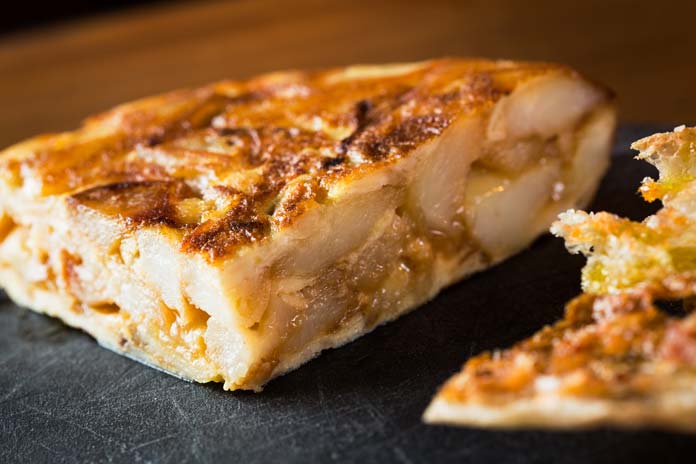
Aceitunas
As simple as it gets, a little portion of olives is a perfect snack. There are over 200 types of olives in Spain, so you have a lot to choose. Campo Real is the most common variety in Madrid. They’re green, delicious and topped with a bit of garlic and oregano.
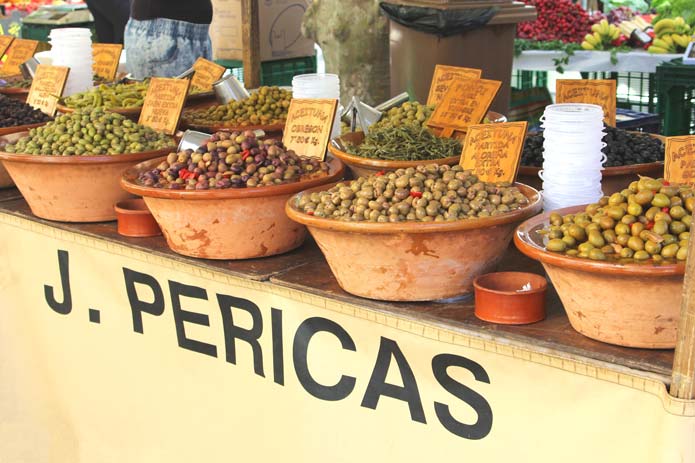
Cocido madrileño
Madrilenian stew is made of chickpeas, meat, and veggies. Chickpeas are obligatory, but other ingredients may vary a bit. There can be some potato, cabbage, carrot, ham, chicken or pork. Traditionally, the ingredients are served separately.
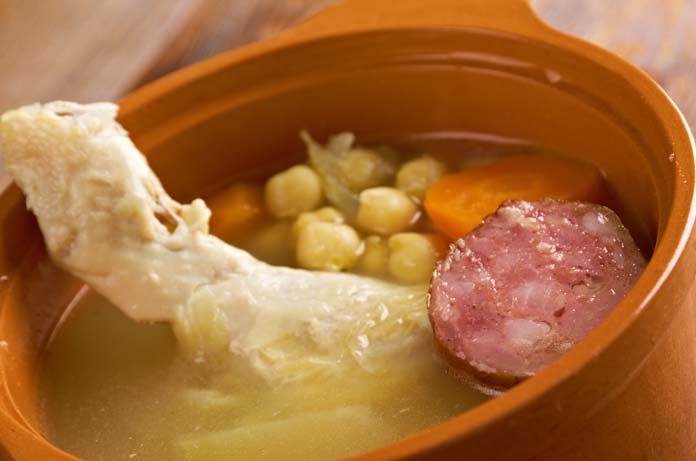
Patatas bravas
That’s a nice vegetarian snack – potato wedges that are first parboiled, then deep fried in olive oil and finally served with sauce. The salsa is spicy and usually made of tomatoes and peppers. Simple but yummy, this dish goes very well with beer.
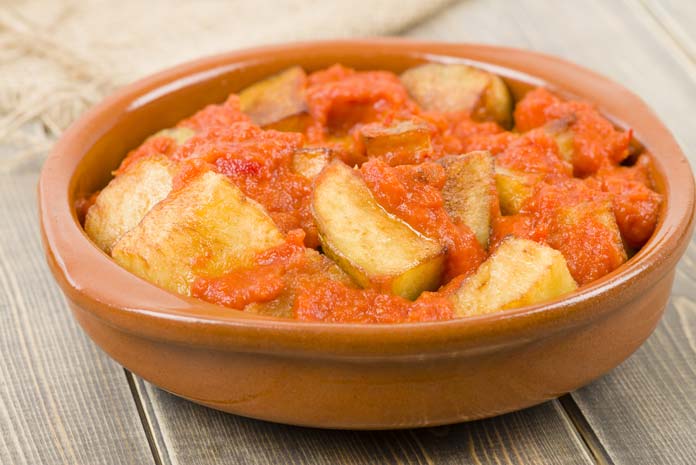
Patatas aioli
An appetizer similar to patatas bravas, but served with garlic mayonnaise instead of the sauce.
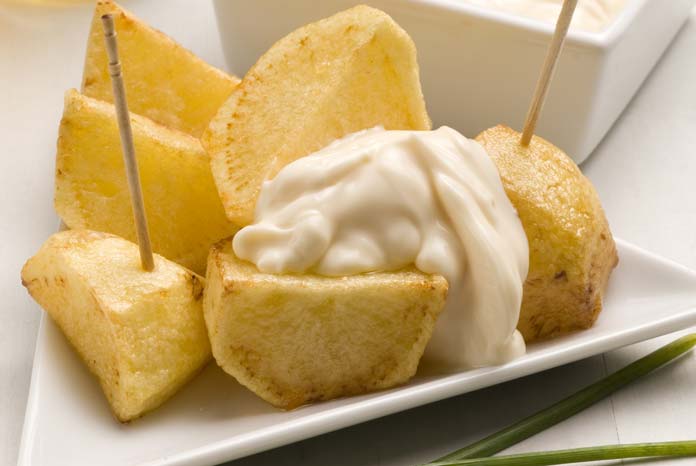
Gazpacho
Gazpacho is perfect for hot summer days. It’s a cold vegetable soup made of raw vegetables. Very healthy and delicious.
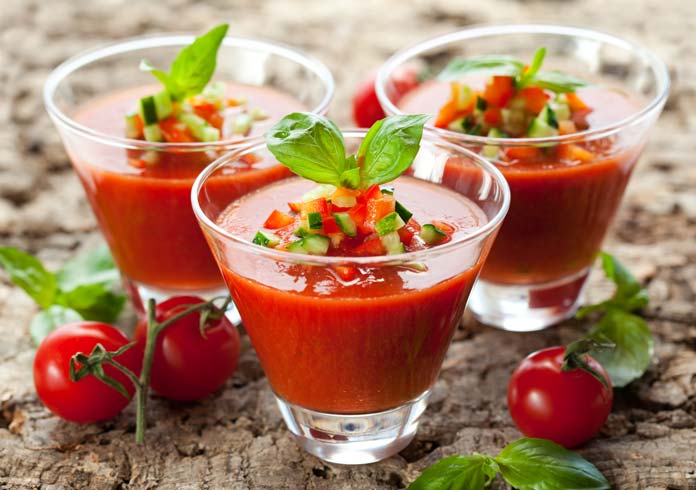
What to do once you’re full?
If you’re a foodie, you’re most likely already convinced Madrid is worth-visiting. If you like exploring different cuisines, but it’s not your priority, you should know the capital of Spain has a lot to offer outside of its bars and taverns as well. It’s a fascinating historical city with countless museums, galleries, and plazas. You can’t leave it without seeing the Plaza Mayor, its most central and famous square. You should also visit the beautiful Palacio Real, one of the largest palaces in Europe. If you’re an art-lover, don’t miss the Museum Triangle. It consists of the Museo del Prado (fine arts), the Thyssen-Bornemisza (classical art) and the Reina Sofia (modern art). To relax and stroll about (you might need some exercise after all the food!), go to El Retiro Park, Madrid’s central park and one of its landmarks. Last but not least – don’t miss a chance to see a flamenco show, especially if you’re interested in dance.
Independent discoveries vs. organized tours
You can either explore Madrid on your own or use the help of professional guides. Both options have their advantages and disadvantages, of course, but most of all you should know you have this choice. There are many companies offering tapas tours in Madrid. The guides are usually locals, and they know their city very well. They also know the most authentic and traditional or the unique and innovative eateries. Some of the companies, such as the Native Tapas Madrid (see here), combine food tours with visiting various attractions. The historical tour, for example, includes a nice walk around Madrid, discovering some of its most attractive squares and markets, as well as trying out a variety of tapas.
Have you ever tried Spanish snacks? Let us know! And don’t forget to share this article with your friends.



